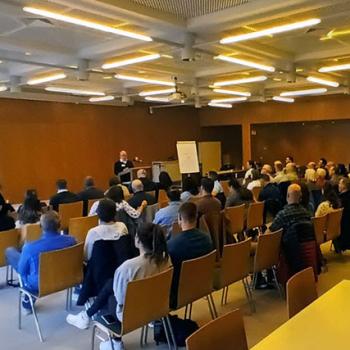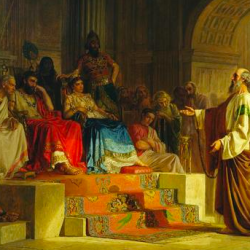By Samuel Brown - June 9, 2009
Photo by Ben Spackman
 Death is a crucial test of a religious tradition. In the words of one sociologist, "the power of religion depends, in the last resort, upon the credibility of the banners it puts in the hands of men as they stand before death, or more accurately, as they walk, inevitably, toward it." Mormonism has a long and rich relationship with death and its conquest, one that begins in many respects with the founding family of Mormonism.
Death is a crucial test of a religious tradition. In the words of one sociologist, "the power of religion depends, in the last resort, upon the credibility of the banners it puts in the hands of men as they stand before death, or more accurately, as they walk, inevitably, toward it." Mormonism has a long and rich relationship with death and its conquest, one that begins in many respects with the founding family of Mormonism.
Joseph Smith was centrally occupied with the conquest of death. In crucial respects his theology and ritual system charted for his followers the path to a world beyond death. Despite its distinctive ultimate form, early Mormon death culture differed little from that of lay Protestants. This "good," "beautiful," or "holy" death placed dramatic emphasis on the deathbed as a religious ritual and enjoined dramatic mourning on the part of the bereaved.
In the early years of Mormonism, beliefs about heaven were undergoing dramatic change, from the theocentric heaven of Augustine and Calvin-the view espoused by most Reformed clergy in which personal attachments melded into the heavenly body of Christ-to a domestic view of heaven in which families would be reunited in heaven to live together forever.
Joseph Smith codified and ritualized these beliefs, applying a divine anthropology, a patriarchal priesthood, a temple liturgy, and rites recovered from ancient Christianities like Baptism for the Dead to the problem of the conquest of death. By the time he died, Smith had established a system that largely erased death's significance. Death became a minor transition, and afterlife resembled nothing so much as a glorious and secure version of mortal life.
Mormons believed then and believe now that they will persist as thinking spirits awaiting resurrection after their death, with no interruption of consciousness. Though never official doctrine, they also tend to believe that such spirits live on or near the earth and remain involved with the living in various ways. These beliefs have led one scholar of Mormonism to claim that, "it is the dead and not death as such that preoccupy active Latter-day Saints."
In the late 19th and early 20th centuries, American culture underwent a process called the "dying of death," a transformation that yielded the late 20th-century view, one that has been criticized for its lack of awareness or cultural touchdowns for death alongside a dangerous stigmatization of mourning. The Latter-day Saints, while preserving their distinctive version of the domestic heaven, acclimated to this cultural change. Some have suggested that church leadership has emphasized the explanatory power of the eternal family at the expense of healthy bereavement. Leaders have urged that funeral services avoid personal memorials and instead preach core doctrines; they have written guidebooks to mourning that attempt to minimize the duration or amount of grieving.
Hoping to demonstrate to themselves and outsiders the great power of their religious system, Latter-day Saints have often focused on the power of their afterlife beliefs to console the bereaved. In Mormon parlance, the dead have often been called to a "greater work" on the "other side of the veil"; deceased infants may have been too pure to require the trials of mortality. In any case, the living will soon, by token of temple "sealings," be reunited with their loved ones. These rituals and beliefs wield considerable power to explain even premature death, helping Latter-day Saints to discover God's beneficent plan in the midst of great suffering.
Striking the right balance of affirmation of the potency of human ties during mortal life while providing consolation to those facing their own death or mourning the loss of a loved one is difficult and often very personal. Yet for many if not most Latter-day Saints, Joseph Smith's ardent defense of the durability of human associations illuminates the path that strikes the best balance of honor and grief. Mourning the absence of a loved one, they look forward to the day that the absence will end forever.
Samuel Brown, MD is an academic pulmonary/critical care physician based at the University of Utah and Intermountain Healthcare. His scholarship focuses on critical care epidemiology and cultural history of sickness and death.
1/1/2000 5:00:00 AM




